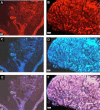Carotid Body AT(4) Receptor Expression and its Upregulation in Chronic Hypoxia
- PMID: 18949084
- PMCID: PMC2570565
- DOI: 10.2174/1874192400701010001
Carotid Body AT(4) Receptor Expression and its Upregulation in Chronic Hypoxia
Abstract
Hypoxia regulates the local expression of angiotensin-generating system in the rat carotid body and the me-tabolite angiotensin IV (Ang IV) may be involved in the modulation of carotid body function. We tested the hypothesis that Ang IV-binding angiotensin AT(4) receptors play a role in the adaptive change of the carotid body in hypoxia. The expression and localization of Ang IV-binding sites and AT(4) receptors in the rat carotid bodies were studied with histochemistry. Specific fluorescein-labeled Ang IV binding sites and positive staining of AT(4) immunoreactivity were mainly found in lobules in the carotid body. Double-labeling study showed the AT(4) receptor was localized in glomus cells containing tyrosine hydroxylase, suggesting the expression in the chemosensitive cells. Intriguingly, the Ang IV-binding and AT(4) immunoreactivity were more intense in the carotid body of chronically hypoxic (CH) rats (breathing 10% oxygen for 4 weeks) than the normoxic (Nx) control. Also, the protein level of AT(4) receptor was doubled in the CH comparing with the Nx group, supporting an upregulation of the expression in hypoxia. To examine if Ang IV induces intracellular Ca(2+) response in the carotid body, cytosolic calcium ([Ca(2+)](i)) was measured by spectrofluorimetry in fura-2-loaded glomus cells dissociated from CH and Nx carotid bodies. Exogenous Ang IV elevated [Ca(2+)](i) in the glomus cells and the Ang IV response was significantly greater in the CH than the Nx group. Hence, hypoxia induces an upregulation of the expression of AT(4) receptors in the glomus cells of the carotid body with an increase in the Ang IV-induced [Ca(2+)]i elevation. This may be an additional pathway enhancing the Ang II action for the activation of chemoreflex in the hypoxic response during chronic hypoxia.
Keywords: Angiotensin IV; angiotensin IV receptor; chemoreceptor; type-I cells.
Figures




Similar articles
-
Postnatal hypoxemia increases angiotensin II sensitivity and up-regulates AT1a angiotensin receptors in rat carotid body chemoreceptors.J Endocrinol. 2002 May;173(2):305-13. doi: 10.1677/joe.0.1730305. J Endocrinol. 2002. PMID: 12010638
-
Chronic hypoxia modulates the function and expression of melatonin receptors in the rat carotid body.J Pineal Res. 2006 Mar;40(2):125-34. doi: 10.1111/j.1600-079X.2005.00286.x. J Pineal Res. 2006. PMID: 16441549
-
Chronic hypoxia enhances endothelin-1-induced intracellular calcium elevation in rat carotid body chemoreceptors and up-regulates ETA receptor expression.Pflugers Arch. 2002 Feb;443(4):565-73. doi: 10.1007/s00424-001-0728-2. Epub 2001 Oct 9. Pflugers Arch. 2002. PMID: 11907823
-
Expressions of angiotensin and cytokine receptors in the paracrine signaling of the carotid body in hypoxia and sleep apnea.Respir Physiol Neurobiol. 2015 Apr;209:6-12. doi: 10.1016/j.resp.2014.09.014. Epub 2014 Oct 3. Respir Physiol Neurobiol. 2015. PMID: 25266394 Review.
-
Roles of ion channels in carotid body chemotransmission of acute hypoxia.Jpn J Physiol. 1999 Jun;49(3):213-28. doi: 10.2170/jjphysiol.49.213. Jpn J Physiol. 1999. PMID: 10529483 Review.
Cited by
-
Peripheral chemoreceptors: function and plasticity of the carotid body.Compr Physiol. 2012 Jan;2(1):141-219. doi: 10.1002/cphy.c100069. Compr Physiol. 2012. PMID: 23728973 Free PMC article. Review.
-
Angiotensin and carotid body chemoreception in heart failure.Curr Opin Pharmacol. 2011 Apr;11(2):144-9. doi: 10.1016/j.coph.2010.12.004. Epub 2011 Jan 15. Curr Opin Pharmacol. 2011. PMID: 21242106 Free PMC article. Review.
-
Dysregulation of the Renin-Angiotensin System and the Vasopressinergic System Interactions in Cardiovascular Disorders.Curr Hypertens Rep. 2018 Mar 19;20(3):19. doi: 10.1007/s11906-018-0823-9. Curr Hypertens Rep. 2018. PMID: 29556787 Free PMC article. Review.
-
Is There an Interplay Between the Functional Domains of IRAP?Front Cell Dev Biol. 2020 Sep 29;8:585237. doi: 10.3389/fcell.2020.585237. eCollection 2020. Front Cell Dev Biol. 2020. PMID: 33134302 Free PMC article. Review.
-
Revisiting cAMP signaling in the carotid body.Front Physiol. 2014 Oct 28;5:406. doi: 10.3389/fphys.2014.00406. eCollection 2014. Front Physiol. 2014. PMID: 25389406 Free PMC article. Review.
References
-
- Gonzalez C, Almaraz L, Obeso A, Rigual R. Carotid body chemoreceptors: from natural stimuli to sensory discharges. Physiol Rev. 1994;74:829–98. - PubMed
-
- Lahiri S, Rozanov C, Roy A, Storey B, Buerk DG. Regulation of oxygen sensing in peripheral arterial chemoreceptors. Int J Biochem Cell Biol. 2001;33:755–74. - PubMed
-
- Dasso LL, Buckler KJ, Vaughan-Jones RD. Interactions between hypoxia and hypercapnic acidosis on calcium signaling in carotid body type I cells. Am J Physiol Lung Cell Mol Physiol. 2000;279:L36–42. - PubMed
LinkOut - more resources
Full Text Sources
Miscellaneous
